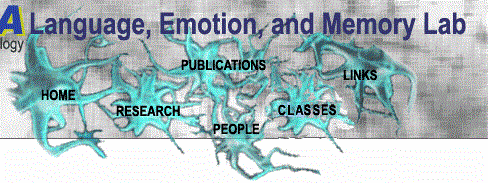|
The primary goal of the LEMLAB is to better understand the relationship between emotion and language and memory processes. Our work in this area has been guided by binding theory (MacKay, Shafto, Taylor, Marian, Abrams & Dyer, 2004; MacKay & Ahmetzanov, 2005; MacKay, Hadley, & Shwartz, 2005; Hadley & MacKay, 2006). Under binding theory, emotionally-salient stimuli (e.g., taboo words) lead to priority binding of the internal representations for these stimuli and their context of occurrence relative to similar emotionally-neutral stimuli (e.g., animal names). The binding process operates rapidly by triggering units within systems that process emotional salience (amygdala) and memory (hippocampus). These automatic binding processes lead to slower color naming times and better recall of words and contextual details for taboo than neutral words in lexical decision, serial recall, and Stroop tasks, (MacKay, et al., 2004, MacKay & Ahmetzanov, 2005). Another aspect of priority-binding in binding theory predicts that under demanding encoding conditions (e.g., rapidly-presented RSVP lists of words), emotionally-salient stimuli will interfere with the encoding of emotionally-neutral stimuli because emotional stimuli become bound to their context with higher priority than neutral stimuli in the temporal neighborhood. Recent research has supported this prediction in two paradigms: immediate recall and orthographic repetition blindness (MacKay, et al., 2004, MacKay, et al., 2005, Hadley & MacKay, 2006). Our current research explores binding theory predictions in greater detail in RSVP, Stroop, and other paradigms.
|
|
Our work on how aging affects binding processes in language and memory has been guided by a general theory of cognitive aging known as the Transmission Deficit Hypothesis (MacKay & Burke, 1990). Under this hypothesis, aging causes a reduction in the strength of connections between nodes in all cognitive systems. Because reduced connection strength impairs the ability to form new connections to represent novel information, older adults perform better when a task involves the use of established, frequently used connections (e.g., reading high-frequency words), but worse relative to young adults when a task requires the formation of one or more new connections (e.g., reading non-words aloud). The Transmission Deficit Hypothesis has also been productively applied to phenomena such as the effects of aging on the Tip-of-the-Tongue phenomenon, and errors in speech production, and the ability to spell familiar words that are either high or low in frequency. Ongoing research in this area involves application of Transmission Deficit and binding principles to effects of aging on retrograde amnesia in H.M., the famous "hippocampal amnesic".
|
- MacKay, D.G., & Ahmetzanov, M, V. (2005). Emotion, memory, and attention in the taboo Stroop paradigm: An experimental analog of flashbulb memories. Psychological Science, 16, 25-32.
- MacKay, D.G., Hadley, C.B., & Schwartz, J.H. (2005). Relations between emotion, illusory word perception, and orthographic repetition blindness: Tests of Binding Theory. Quarterly Journal of Experimental Psychology: Human Experimental Psychology, 58A, 1514-1533.
- MacKay, D. G., Shafto, M., Taylor, J. K., Marian, D. E., Abrams, L., & Dyer, J.R. (2004). Relations between emotion, memory and attention: Evidence from taboo Stroop, lexical decision, and immediate memory tasks. Memory & Cognition, 32, 474-488.
- James, L.E. & MacKay, D.G. (2001). H.M., Word knowledge and aging: Support for a new theory of long-term retrograde amnesia. Psychological Science, 12, 485-492.
- Hadley, C.B. & MacKay, D.G. (2006). Does Emotion Help or Hinder Immediate Memory? Arousal versus Priority-binding Mechanisms. Journal of Experimental Psychology: Learning, Memory, and Cognition, 32, 79-88.
|



